Petascale Institute Introduces Students to High-Performance Computing
June 12, 2015
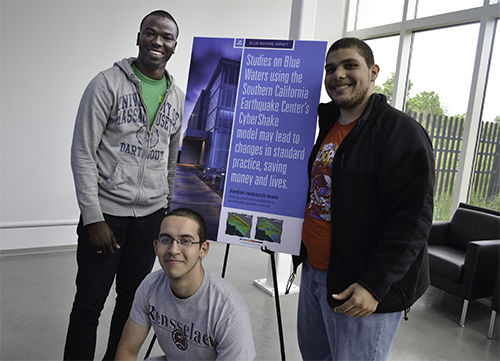
Clockwise from top left: Sidafa Conde, Juan Garcia, and Jorge Alarcon Ochoa participate in a tour of the Petascale Facility, home of the Blue Waters supercomputer.
Most of the 34 students who attended the two-week Petascale Institute May 24th–June 5th are not in computer science; however, by the middle of the second week, they were glibly rattling off HPC (High Performance Computing) jargon, confidently referring to concepts most of us have either never heard of or have no idea what they actually are, like: OpenMP and MPI, vector accelerators, OpenACC, CUDA, debugging, optimization, and visualization. Their goal? To learn enough about parallel computing to be able to use Blue Waters or another supercomputer to analyze data for projects ranging from studying black holes, neutron stars, and galaxies, to natural language acquisition, visualization in cyber security, or protein folding using molecular dynamic simulations.
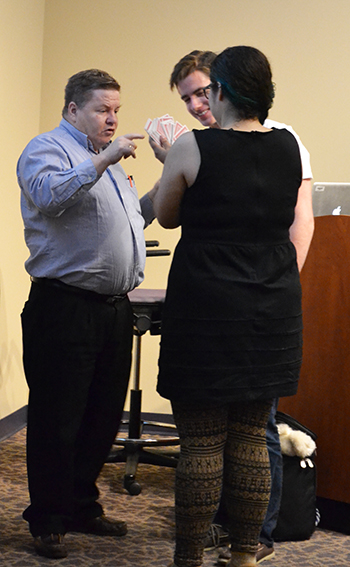
Bob Panoff (left) does a card trick to illustrate parallel computing during one of the Petascale Institute sessions.
According to Bob Panoff, Executive Director of Shodor, NCSA’s partner which provides instruction at the Institute, the curriculum is designed to teach non-computer-science majors in disciplines like physics, biology, genomics, chemistry, and astrophysics, etc., general parallel computing concepts: “What we’ve tried to do at the Institute is find one or more common denominators that we can talk about the problem approach in general, and then each of them can take something very particular to their own project.”
Of the 34 students, 10 were from the XSEDE Scholars program; also attending were three non-XSEDE graduate students who might benefit from Institute training. Rounding out the group were 21 undergrads participating in the Blue Waters Internship program. Panoff explains how interns are selected:
“A mentor proposes a project and says, ‘Here’s a student that I think would be good to work with me.’ The student looks at that project and says, ‘I would like to work with that mentor,’ and if we agree that that’s a good match, then that’s our best predictor of success.” During the interview process, mentors must also explain how their project would benefit from analysis on a supercomputer. Panoff says a project “would not be selected if it’s not at least probable that there would be a good match with the resources.”
After their introduction to HPC at the Institute, students will spend the rest of the summer and the entire next school year working on their project.

Blue Waters Intern, Kiara Wootson
Interestingly, all of the mentors aren’t up on HPC. In fact, in some cases, the mentor is sending their student to “learn it and bring that knowledge back.” In some cases, the mentor is an expert, and is looking for the Institute to train their student to work with them.
According to Panoff, mentors range from “people that have a lot of data and are hoping that high-performance computing is going to help them, all the way up to people that have a code and they’re looking for another student to work on the next improvement to that code.”
How did the students do? “Very, very well,” reports Panoff. “We have gotten through the major topics of how to use parallelism by distributing the work among processors…” then goes on to recite parallel computing jargon describing all they've learned.
Regarding debugging, the goal is to help students “understand the many, many sources of the problem.” He goes on to explain problems that can occur:
“It could be that you wrote the wrong program; you could have had the wrong algorithm; you could have had the wrong model; you could have a problem with memory; you could have had a problem with one of the processors coming back slower and messing up the synchronization; you could have had, actually, a hardware problem. You could have something that glitches, and then say, ‘Ok, now how do I save the work that I have done, and then progress further, and then go back in?’"
In addition to debugging, another unique parallel computing skill students acquired was patience when running jobs in batch mode:
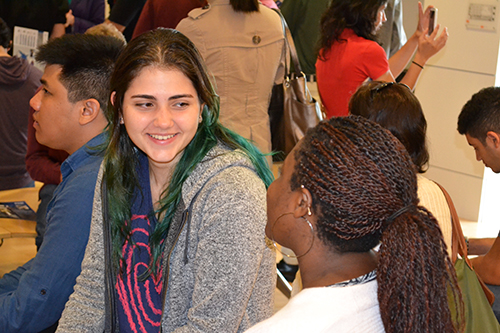
Petascale Institute participants chat during a tour of the Petascale Facility .
According to Panoff, “A lot of these kids are young enough that they’ve never run in batch mode, where you submit a job, let it run, and then come back. They’re more used to interactive dynamic computing where you get on the computer and run the code, and it’s the code that’s right in front of you.”
“Part of this is almost learning to be detached,” he continues. “‘Ok, let me set up the work that needs to be done; let me submit it to the queue; let me wait for it to come back, and now I have to look at the answer and say, ‘Ok, what have I learned?’ It’s a different style of computing than many of these kids have been used to.”
Panoff was excited about the number of students from underserved populations in this year’s group, such as XSEDE Scholar Wanda Moses. A Ph.D. student in Computer Science at Clemson University, Moses reports, “I am really learning some great stuff here, this week, last week. It’s a whole lot of information, so I’m going to find some kind of way to match it with my research…and be able to present it in some type of visualization application.”

Students watch a 3D visualization presentation at NCSA.
“I like the visualization aspect,” Moses continues, “where you can take all of this data and put it so that people can see it and use it.”
Moses says her dream career would be academia, filling a very specific niche: using data visualization in the area of cyber security. She explains, “I want to work with the government using the super computing, but at the same time I want to teach as an adjunct professor at the university level because I really enjoy teaching.”
A 20-year Navy veteran preparing for her second career, Moses ended up at the Petascale Institute through a rather circuitous route.
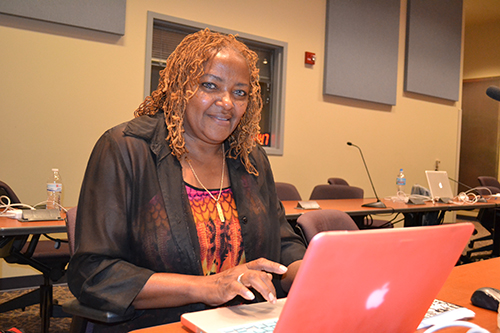
XSEDE Scholar Wanda Moses, a Ph.D. student in Computer Science at Clemson University.
When Moses got out of the Navy, she decided to go back to school. She describes how she chose her next career: “I looked down the list of things that I wanted to do. I didn’t want to work for customer service, because that’s what I had done; I worked in a personnel office in the Navy most of the time. So I’m like, ‘I don’t want to deal with people so much; I want to deal with computers.’ That was the best fit for me, the Computer Science program.” She also loves math, so she did a double major: computer science and mathematics.

I-STEM evaluator Lorna Rivera (right) chats with XSEDE Scholar Efraín Vargas Ramos, a grad student at University of Puerto Rico at Río Piedras.
She was happily progressing through her undergraduate work, intending to finish her degree and then get a job. But then, her junior year, she did a research project, and fell in love with visualization: “I had a research project when I was an undergrad with the Hubble Space Shuttle. We had all of this data…and we had to write a computer program in Matlab to create a visualization for that. I had to create an algorithm, but…all this was new to me, it wasn’t fitting, it was just little pieces of a puzzle.”
Then she got the wake-up call and decided to aim even higher: “For this work we did, I got $4,000, the instructor with a Master’s degree got $8,000, and the Ph.D got $16,000. I seemed to have put in more time than they did, so I’m like, “I’m going to get my Ph.D.”
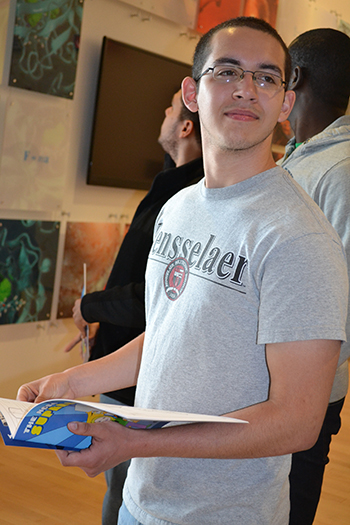
Blue Waters intern, Jorge Alarcon Ochoa, a junior majoring in physics at Rensselaer Polytechnic Institute
According to Panoff, the Institute also had more Hispanic students than they’ve ever had before.
One Blue Waters intern, Jorge Lacomatura, a junior from Rensselaer Polytechnic Institute, is majoring in physics, specifically computational and theoretical biophysics. He explains that attending the Institute was important because he intends to use supercomputers in his career: “I concentrate on the study of protein folding, and protein folding uses molecular dynamic simulations which need high-powered computing to actually perform and obtain data, so if I don’t have a supercomputer, I don’t have a job.”
XSEDE Scholar Efraín Vargas Ramos is a grad student working on a Master's in applied math at University of Puerto Rico at Río Piedras. His future plans are to work in an industry or get a Ph.D. possibly in Software Engineering.
Another XSEDE Scholar, Juan Castro-Garcia, a Michigan State PhD student in Computer Science and Engineering, hopes to be a professor at a Research 1 university, study Natural Language Processing and Cognitive Science, and intends to use parallel computing to integrate “multiple input styles, like text, audio, video, and try to simulate how the human mind can learn a language.”
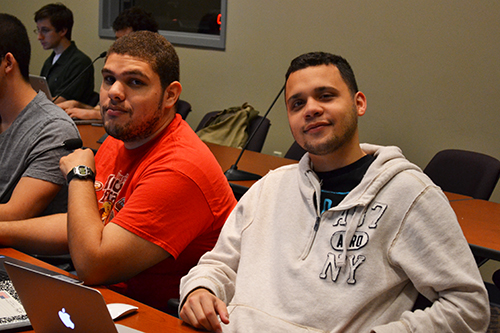
XSEDE Scholars Juan Castro-Garcia (left) and Efrain Vargas Ramos (right) during one of the Institute sessions.
Castro-Garcia further explains his natural language acquisition project: “I’m trying to use a model called a developmental network, which in theory tries to model the brain as an emergent Turing machine, to try to determine how we can learn multiple languages, like English, French, Mandarin, and how to associate it into this Turing machine.
XSEDE Scholar Sidafa Conde, a Ph.D. student at the University of Massachusetts, Dartmouth who is studying Computational Science and Engineering hopes for a career in HPC. Conde, who attended the Institute “to learn new methods as well as collaborate with other like-minded individuals,” reports learning a variety of things he hopes to implement in his future research.
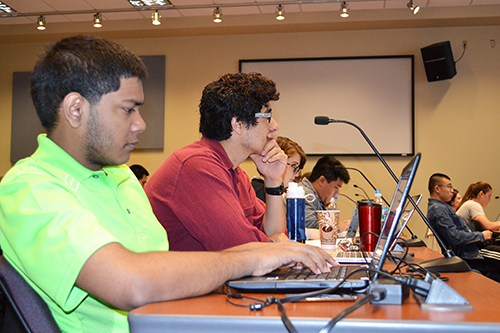
Petascale Institute participants during one of the sessions.
How many of the Institute participants will actually end up in HPC? Panoff says that based on their track record in previous years, 75% to 80% will most likely apply to grad school or continue on in a project that uses high-performance computing and stay active in the Blue Waters and XSEDE communities.
What if they don’t go into HPC? Will they still be able to use what they’ve learned? According to Panoff, “You cannot buy a computer today that’s not a parallel computer.” However, almost none of the software runs in parallel. But Panoff says they’ve taught these students how to actually remedy that.
“So we’ve given them tools that will let them turn their own laptop into a learning environment for parallel computing,” Panoff explains, “even though, instead of talking about thousands of cores, we’re only talking about four. But still, the same type of thinking goes on that can make that happen.”
I-STEM article on last year's Institute: Interns Have an Up-Close-and-Personal Encounter With Blue Waters
Story and photographs by Elizabeth Innes, Communications Specialist, I-STEM Education Initiative.
More: Computer Science, Summer Research, Undergrad, Underserved Minorities, 2015
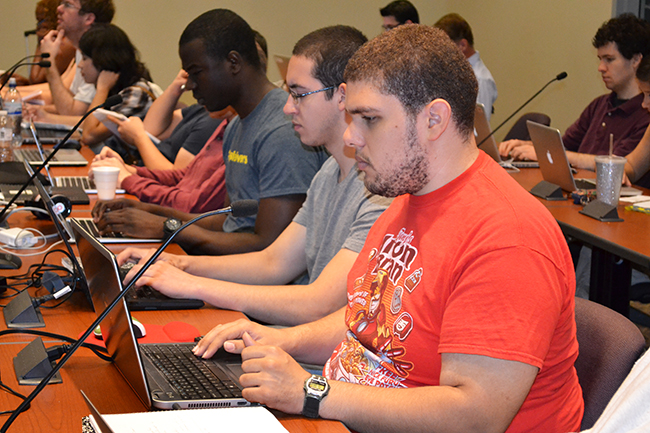
Students working at their laptops during one of the sessions at the Petascale Institute.













.jpg)
















